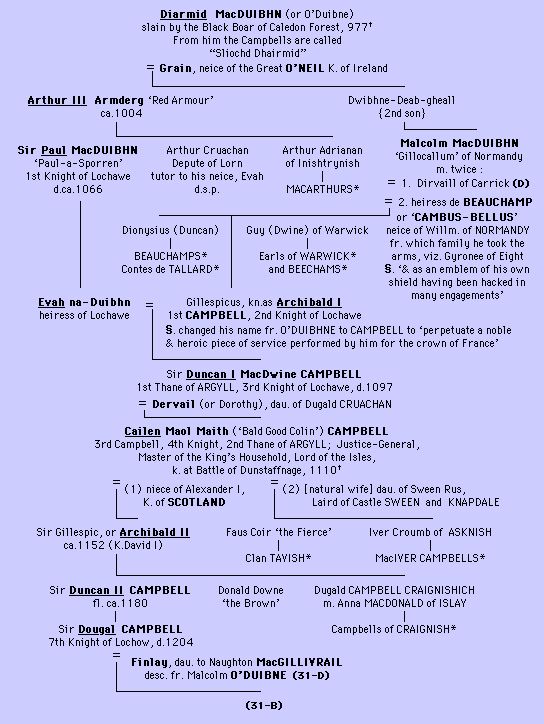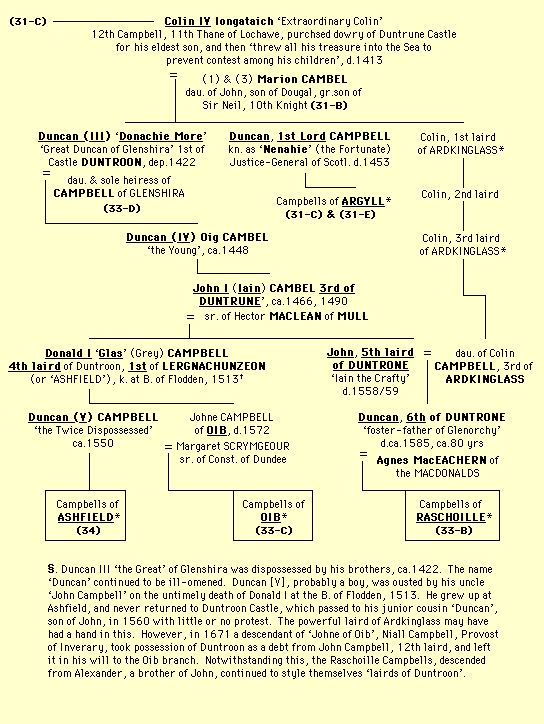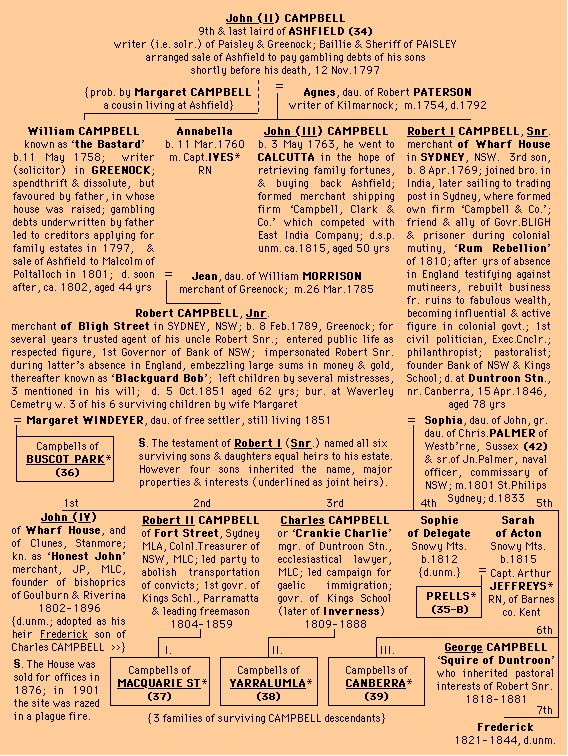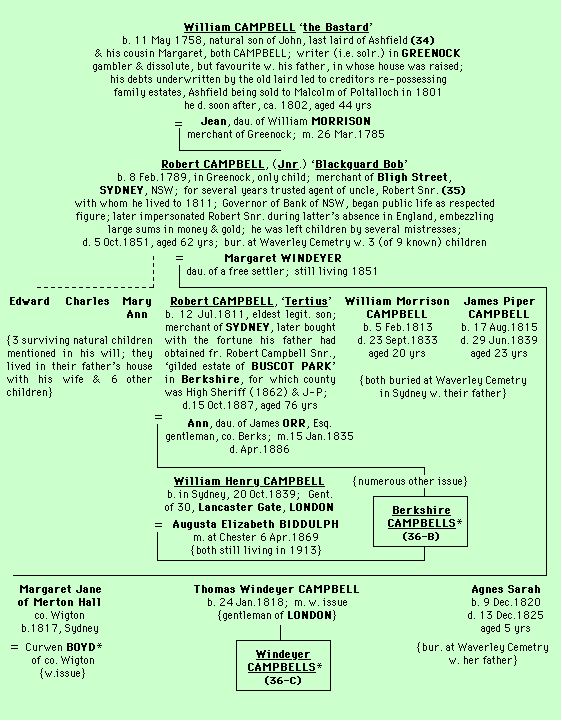Campbells of Lochawe
Chieftains of Argyll ('Land of the Gael')
A- From: Diarmid
MacDuibhn to Dougal Campbell, 977 to 1204
B- Seven Knights from Dougal
to Cailen Iongataich, 1204-1413
C- From: Cailen Iongataich
to Limpie Brow, 1413-1529
Other Branches-
33- Campbells of Duntroon,
1413-1585
34- Campbells of Ashfield
(Lergnachunzeon), 1513-1797
35- Campbells of Wharf
House, 1797-1896
36- Campbells of Buscot Park, 1789-1913
38- Campbells of Yarralumla
(& Cooinbil), 1846-1973

Seven Knights from Dougal to Cailen Iongataich
1204-1413

Descendants of Cailen Iongataich
(1413-1529)




§. NOTE [Error]/ Frederick Campbell was NOT adopted by John Campbell of Wharf House as his heir, although he did work closely with him for a time, and was in effect 'apprenticed' to his uncle with a view to taking over the business.
This in fact never took place, as Fred preferred the beauty, tranquility and challenge of the wild country of the Australian outback to a life chained to a desk in Sydney, even beside his beloved Sydney Harbour.
My grandfather had this idea from his wife, Fred's daughter and my late grandmother, but I mistakenly confused 'business apprenticeship' with a change of legal status, for which mistake I sincerely apologise to any who may have been inadvertently offended or caused alarm.

§. NOTES/ [1] Robert Campbell 'Junior' of Bligh Street (1789-1851), titular '11th laird' of Ashfield after the premature death of William his father, was a complex, lively and important figure in the colony, as financier, banker and founder of a gold broking business with his son, Robert 'Tertius' (see below). Despite character flaws, he felt loyalty and obligation to his natural children, whom he mentioned in his will, showing an enlightened sentiment which was well ahead of his time. He fiercely promoted the fortunes of his family, encouraging his eldest son Robert [III] to return to England and to use his great wealth as an entrepreneur to foster 'enlightenment' values well advanced of the times. The father Robert, always kn. as 'Junior' to distinguish him from his uncle Robert 'I' and cousin Robert 'II', was also a major figure in the establishment of the racing industry in Australia, probably reflecting an enduring Campbell family fondness for both horses and speculation. The epithet 'Blackguard Bob' taught to us by our grandfather may reflect only one side of a far more interesting and important figure than I have done justice to, and whose reputation I may have impetuously maligned.
§. [2] / Campbell's of Buscot Park/ Robert 'Tertius' Campbell (1811-1887) acquired the palatial house and gardens in Berkshire in 1859, and set about 'to turn Buscot into the most highly industrialised farm in the country' (Faringdon, 2015). In particular, he set up a distillery to produce whiskey from sugar beet using a futuristic sustainability model based on harnessing the power of a mill stream, with radically enlightened employment conditions. At the height of his career, he was High Sheriff for co. Berkshire and a leading Justice of the Peace. Although the business foundered in 1879 due to an economic depression and was sold to recover debts, Robert and his wife Anne Orr were able for twenty years to raise seven children in the most beautiful and opulent surroundings, including a magnificent baroque garden and spectacular art collection.
§. [3] Two of the seven gained great notoriety. Florence Campbell (1845-1878) 'of The Priory, London', 2nd daughter, greatly loved by her father as a child, and considered a great beauty in her youth, was called as chief witness in the coronial inquest into the death of her second husband, Charles Bravo, by antimony poisoning, and drank herself to death soon after; Robert [IV] Campbell (1843-1885), 2nd surviving son, was an adventurous traveller who introduced merino sheep to New Zealand, and became a politician and grazier there before also succumbing to alcoholic poisoning after a rabbit plague destroyed his flock. As can be seen, the ascription 'Berkshire Campbells' is at best misleading!
§. [4] Campbell's of Surrey / Thomas [I] Winder Campbell (1818-1869) [in all the records I have come across/ NOT 'Windeyer' as stated above], was [fifth?] surviving son of Robert Campbell 'Junior', and of Margaret née Winder[?], both of Bligh Street and later of Paddington, N.S.W. Thomas became associated with Boyd Town and Twofold Bay, N.S.W. as storekeeper and magistrate. He m. Maria Louisa, and their son Thomas [II] Robert Curwen Campbell (1843-1909?) became a Minister in the Church of England esp. associated with Bathurst before accepting a number of posts in England, his descendants I understand being mostly connected with co. Surrey. However, a curious postscript to this note is that a former tennis partner of my father, the late Dr. John Dowling, told him after a tennis match some time in the early 80's, that the Dowlings, Campbells and Wind'EY'ers had all come out to Australia on the same boat. After some questioning, my father gathered that he was speaking of Robert Campbell 'Junior' and the well-known 'Windeyer' family of whom were a supreme court judge and several other prominent jurists. Was Margaret really a 'Windeyer' after all, the shortened form 'Winder' being some kind of abbreviation in deference to pronunciation?
38. Campbells
of Yarralumla
(site-building currently in progress - try again
after 4/2002)
Go
to List of Campbell Chieftains...